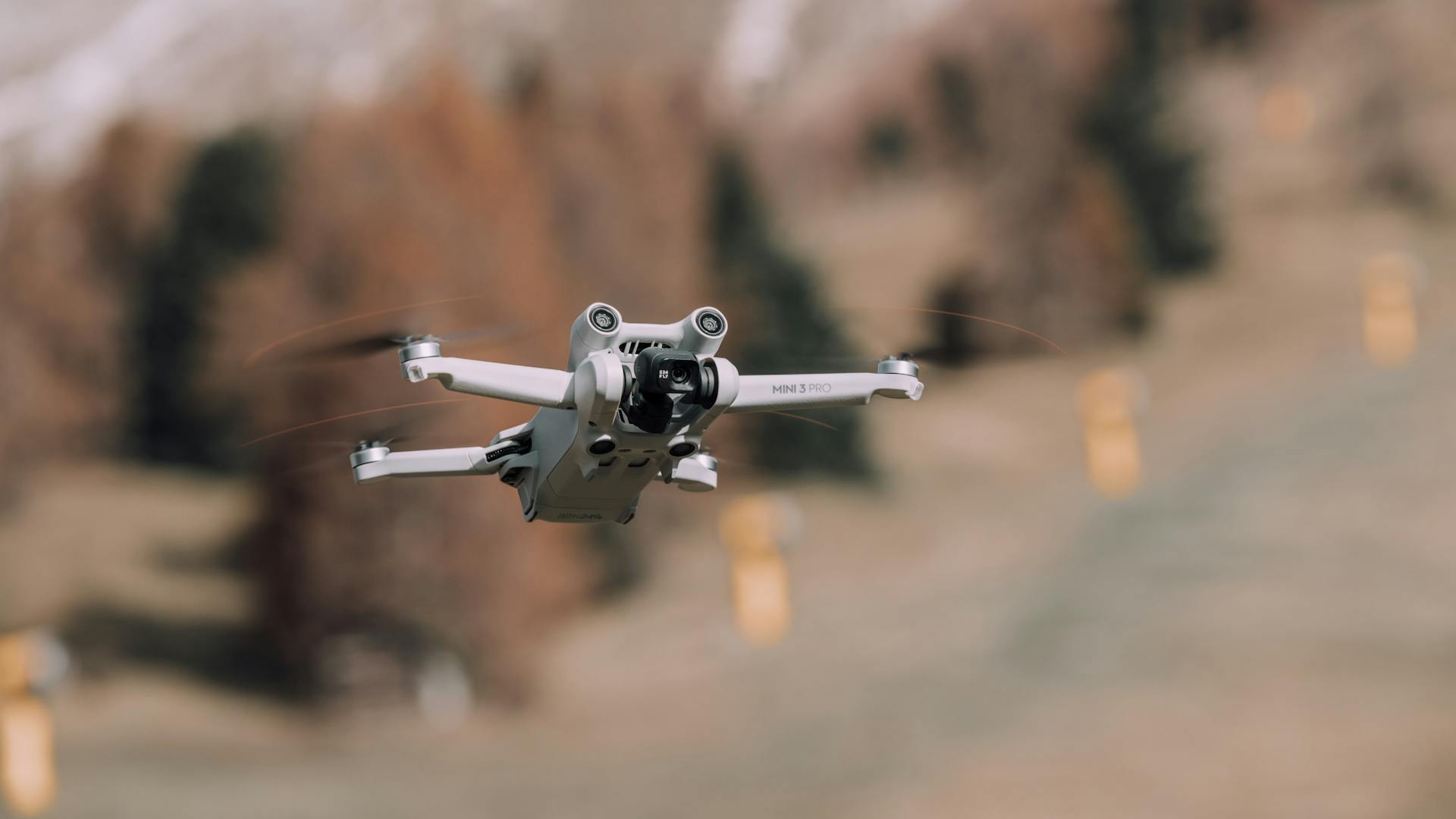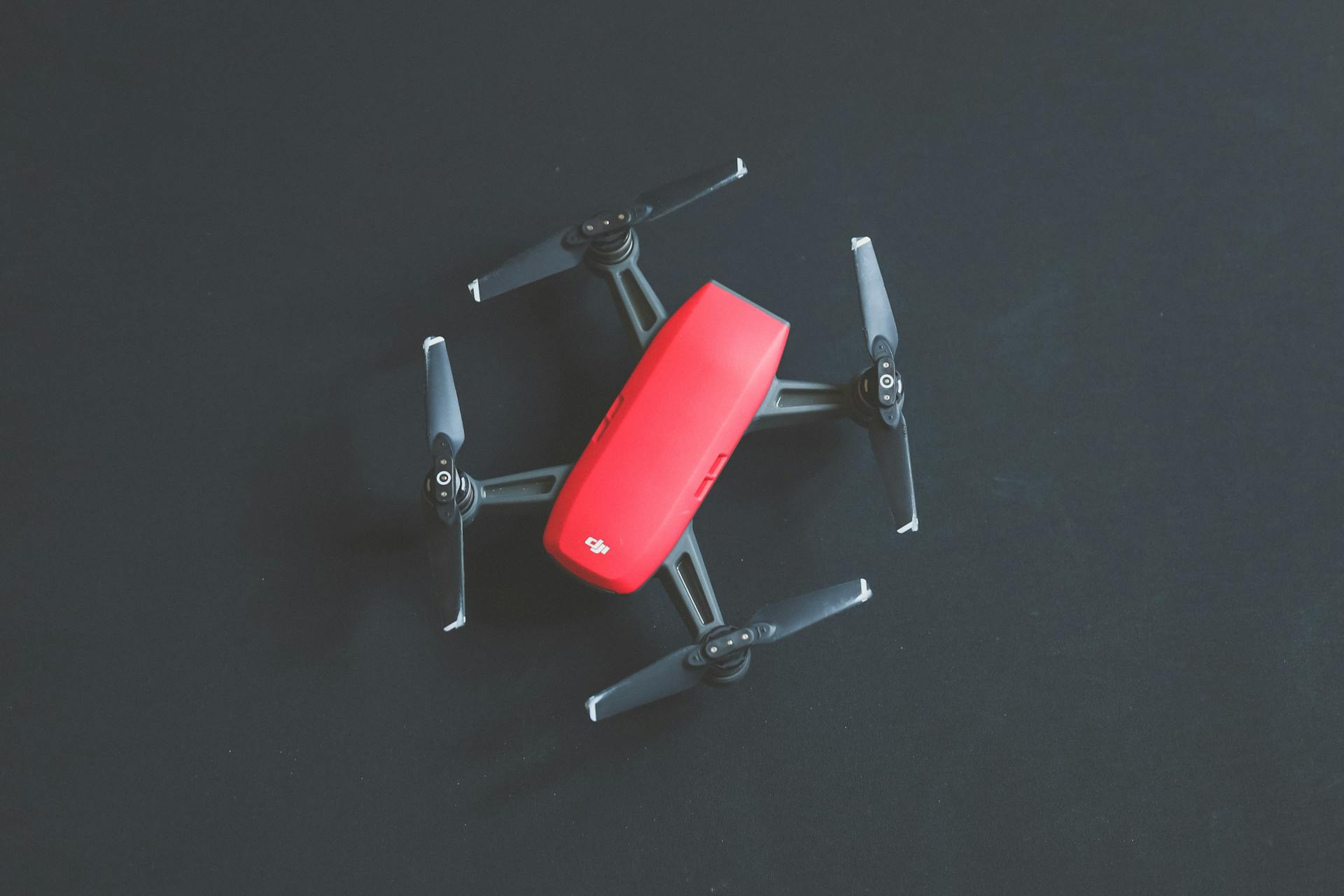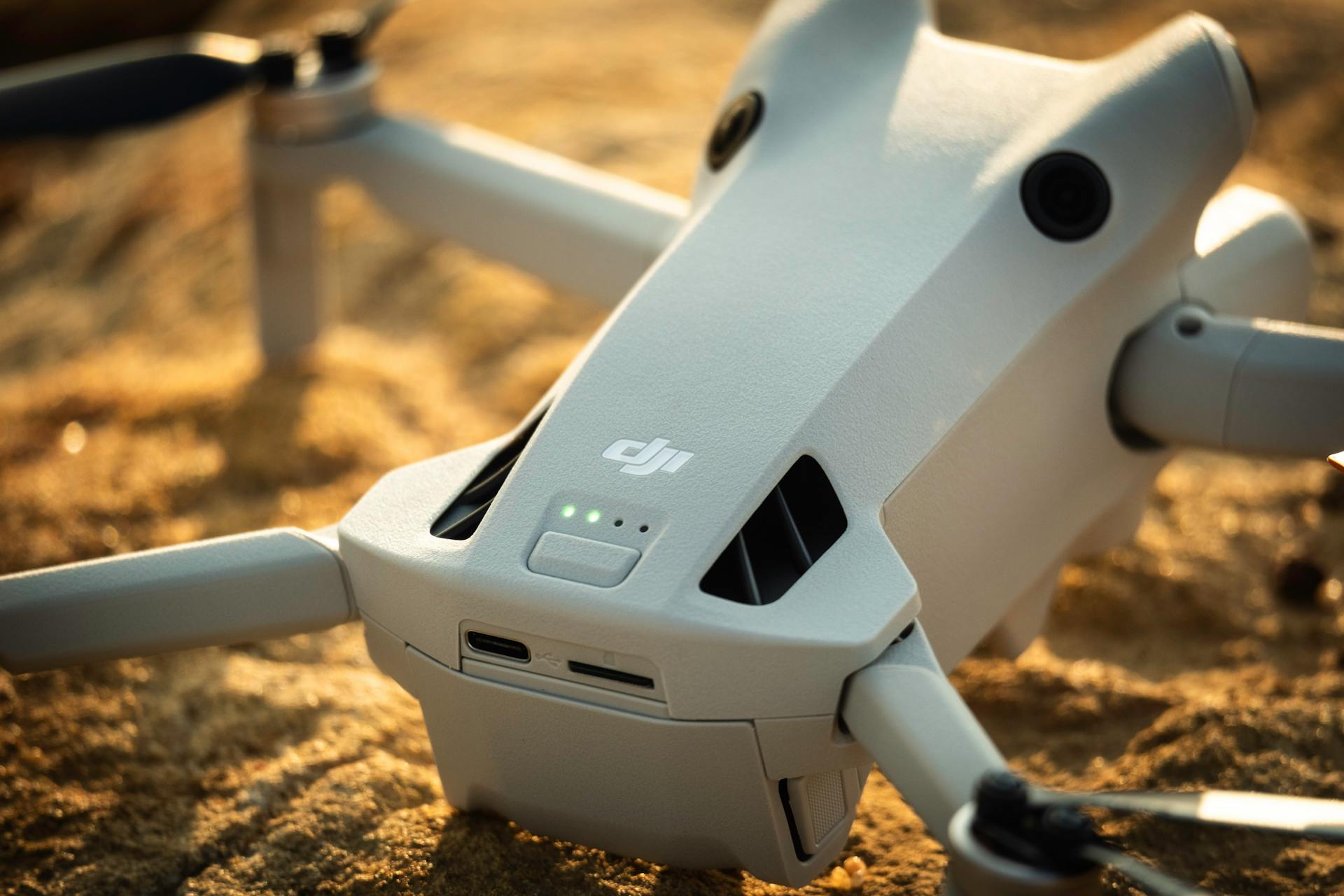
The DJI Phantom 3 is a popular drone that's known for its impressive specs and performance. It's a great choice for hobbyists and professionals alike.
This drone has a maximum flight speed of 35 mph and a maximum flight time of 25 minutes.
One of the standout features of the Phantom 3 is its 12-megapixel camera, which captures stunning photos and videos.
The drone's GPS and GLONASS positioning systems ensure stable and accurate flight, even in windy conditions.
With a range of up to 3.1 miles, you can capture footage and photos from a variety of angles and vantage points.
Camera and Image
The DJI Phantom 3 camera is a major upgrade from its predecessors, with improved low light capabilities and stunning image quality.
The Phantom 3 Standard has a 12-megapixel camera that can shoot 2.7K video at 30fps, while the Phantom 3 SE can shoot 4K video at 30fps. The camera is mounted on a 3-axis gimbal that keeps the camera stable, even in windy conditions.
Here's an interesting read: Dji Mini 2 Se Camera Drone with Remote Controller Bundle
The camera can be controlled using the DJI Go app, which allows you to adjust settings like ISO, shutter speed, and exposure. This is especially useful for capturing the perfect shot.
The Phantom 3 camera has a 94-degree field of view, perfect for capturing wide-angle shots. This is thanks to the camera's 3-axis gimbal, which provides smooth and stable footage.
Here's a breakdown of the camera's video resolutions:
The camera's shutter speed is 1/8000 s, making it ideal for capturing sharp images in a variety of lighting conditions.
Flight and Performance
The DJI Phantom 3 has a maximum flight speed of 35 miles per hour, which is suitable for basic action shots but may not be enough to follow fast-moving cars on a highway.
In terms of flight time, the Phantom 3 Standard, SE, and 4K models can fly for up to 25 minutes before the battery runs out, while the more advanced models have a slightly lower flight time of 23 minutes.
The Intelligent Flight mode allows the drone to follow a specific path or circle around a subject, making it perfect for capturing stunning aerial footage.
Flight Speed
The DJI Phantom series drones can reach a maximum flight speed of 35 miles per hour or 56 kilometers per hour when using the ATTI mode.
This speed allows for basic action shots, but following objects or cars at high speeds can be challenging.
To capture serious action shots or follow a fast-moving car on a highway, you'll need a faster speed than what the DJI Phantom series drones can offer with 35 mph.
Consider reading: Dji Action 2 How to Update Firmware
Flight Performance
The DJI Phantom series drones are equipped with impressive flight performance features. The Intelligent Flight mode allows the drone to follow a specific path or circle around a subject, perfect for capturing stunning aerial footage.
This mode is incredibly useful for beginners and experienced pilots alike, making it easy to capture professional-looking shots. The Return to Home feature is also a game-changer, allowing the drone to return to its takeoff point if it loses signal or the battery is running low.
The maximum flight speed of 35 miles per hour or 56 kilometers per hour is sufficient for basic action shots, but may not be enough for serious action shots or following a fast-moving car on a highway. This speed is normally obtained when using the ATTI mode.
A different take: Dji Action 2 Power Combo
3 vs 2

The debate between 3 and 2 is a crucial one in flight and performance. In terms of stability, a 3-axis autopilot system is generally more stable than a 2-axis system.
Having a third axis allows for more precise control and navigation. This is especially important for long-distance flights where a stable system is crucial.
A 3-axis system can also handle turbulence better than a 2-axis system. This is because it can adjust to changes in air pressure and wind resistance more effectively.
In contrast, a 2-axis system can be more prone to oscillations and loss of control. This is because it relies on a single axis to maintain stability.
However, a 2-axis system can be more energy-efficient than a 3-axis system. This is because it requires less power to operate and maintain.
Ultimately, the choice between 3 and 2 depends on the specific needs and requirements of the flight.
You might like: Dji Mini 4k Drone with Remote Control
Design and Build
The DJI Phantom 3 Standard has a sleek and sturdy design made of high-quality plastic that is durable and lightweight.
The drone weighs just 1216 grams, making it easy to carry around.
Its foldable arms make it more compact and easy to transport.
The remote controller has a built-in phone holder that's compatible with most smartphones, allowing you to control the drone with ease.
The controller has a range of up to 500 meters, which is quite impressive.
On a similar theme: Dji Phantom 3 Controller
Features and Modes
The DJI Phantom 3 has some amazing features that make it a joy to use. Auto Video Mode is incredibly effective, smoothly transitioning between changing lighting scenarios and adjusting ISO and shutter speed on the fly.
You can also EV shift while in Auto Mode by rolling the right index dial, which is super useful for shooting into bright lights or low light environments. I found this feature particularly handy while flying into a bright sky in Florence and Tuscany, where I was able to prevent the sky from getting blown out by shifting the exposure by -⅓.
Exposure Bracketing is another powerful feature that lets you capture 3 or 5 exposures, which is perfect for manual blending or HDR effects. The Phantom 3 can capture all exposures quickly with very little lag time, making it easy to get the shots you need.
Low Light Performance
The DJI Phantom 3 camera boasts impressive low light performance, allowing for high-quality shots in dimly lit conditions.
One of the standout features is the low noise from night flight shots, as seen in the examples of Florence and Manarola.
These shots were taken straight out of the camera, with no additional editing, and are just downsampled to web resolution.
The results are truly impressive, with minimal noise and excellent color representation.
The DJI Phantom 3 camera is a significant upgrade from GoPro's low light performance, which often struggled to produce clear shots in low light conditions.
Overall, the DJI Phantom 3 camera's low light capabilities are a major selling point, making it an excellent choice for photographers who need to shoot in low light environments.
For your interest: Phantom 3 Advanced Constant Beeping Red Light
Raw Dng Files
The Phantom 3 shoots RAW DNG files that capture much more dynamic range than a typical jpeg.
These DNG files can be edited in Adobe Camera RAW or Adobe Lightroom with great results.
Shooting in RAW allows for a lot of flexibility in post-processing, and I was able to take advantage of this while editing a photo of the Vatican in Rome during a beautiful sunset.
The dynamic range is very impressive, and with a single RAW file, you can achieve great results.
Exposure Bracketing and Shooting Modes
You can access a few different shooting options by pressing and holding the shutter button, including burst mode, timelapse, and exposure bracketing.
Exposure bracketing is a powerful feature that allows you to capture multiple exposures quickly, with very little lag time.
With exposure bracketing enabled, you can choose to shoot either 3 or 5 exposures, making it ideal for manual blending or HDR effects.
Obstacle Sensors
The Phantom 3 drones have two cameras, one for shooting video and one for stabilization. This setup helps the drone avoid obstacles that are visible looking down.
The bottom sensor or camera is a good safety feature to have, but it still falls short of what more recent DJI drones offer.
This sensor helps the drone stay steady in an indoor environment, recognizing patterns below the drone and contributing to overall stabilization of the aircraft.
Flights that are closer to the ground at lower altitudes become steadier due to the bottom sensor.
Drone-Controller Link
The drone-controller link is a crucial aspect of flying a drone. The Phantom 3 Standard and the Phantom 3 SE both use Wi-Fi to communicate with the remote controller or mobile device. Wi-Fi has a lower range and is an older technology.
The Phantom 3 4K, Advanced, and Professional models all use the upgraded Lightbridge communication protocol. This is a significant upgrade over Wi-Fi, offering a more advanced link between the controller and the drone.
Related reading: Dji Rc 2 Remote Controller for Air 3 Drone
GPS
The GPS system is a crucial feature of the Phantom 3 drones. They use a combination of GPS and GLONASS systems for redundancy and more accurate navigation. This redundancy ensures that the drone stays on course even if one system fails.
Auto Mode
The auto video mode is a game-changer for capturing smooth and well-exposed footage in changing lighting scenarios. It automatically adjusts the ISO and shutter speed on the fly, resulting in a wide dynamic range that's perfect for sunsets and sunrises.
Related reading: Dji - Mini 2 Se Drone with Remote Control
You can even EV shift while in Auto Mode by rolling the right index dial, which is super useful when shooting into bright lights or low light environments. For example, if you're flying into a bright sky, you can EV shift -⅓ to prevent the sky from being blown out.
The auto video mode is so easy to use that you'll rarely need to switch to manual mode, unless you're looking for a specific creative effect. And even then, it's easy to adjust the footage in post-production to get the look you want.
Game Changer
The DJI Phantom 3 is a game changer for drone enthusiasts. It's not just an upgrade, but a completely new product that offers pinpoint precision and responsiveness in the air.
Flying the Phantom 3 is like flying a finely tuned piece of engineering mastery. The dramatic increase in power is immediately noticeable, and it's clear that this drone is built to perform.
The Phantom 3's responsive control and agility are impressive, and it's a big step up from its predecessor, the Phantom 2. But what really sets it apart is its ability to torque its engines twice before takeoff to tighten the props and assure a smooth flight.
Specifications and Details
The DJI Phantom 3 is a powerful and feature-rich drone that's packed with impressive specs. It has a maximum flight speed of 35 mph and a maximum altitude of 13,400 feet.
The Phantom 3's camera is a highlight of the drone, capturing stunning 12-megapixel photos and 4K videos at 30 frames per second. This camera is also stabilized with a 3-axis gimbal, ensuring smooth and stable footage every time.
The drone's battery life is another notable feature, with a maximum flight time of 25 minutes on a single charge.
Operating Temperature
The operating temperature is a crucial aspect to consider when using your Phantom 3 drone. Both the remote controller and the aircraft have an operating temperature range of 0°C to 40°C.
This means you can fly your drone in a variety of environments, from the cold winter months to the warm summer days.
Sensor Size
The Phantom 3 Standard and the Phantom 3 SE both use a Panasonic 1/2.3-inch CMOS sensor offering 12 megapixels.
The Phantom 3 4K uses a Sony EXMOR 1/2.3-inch CMOS sensor, which is a notable upgrade from the standard models.
The Phantom 3 Advanced and the Phantom 3 Professional both use a slightly improved Sony 1/2.3-inch CMOS sensor offering 12.4 megapixels, giving them a slight edge in image quality.
Related reading: Ar Drone 1
Maximum Bitrate
The maximum bitrate of your Phantom 3 drone is a crucial spec to consider. The Phantom 3 Standard and Advanced models have a maximum bitrate of 40 Mbps.
This means you'll get high-quality video, but not quite as high as some of the other models. The Phantom 3 SE, 4K, and Professional drones have a higher maximum bitrate of 60 Mbps.
To put things into perspective, a Blu-Ray has a bitrate of 25 Mbps. So, the Phantom 3 drones can record video at 2-3 times the quality of Blu-Ray.
DJI 3 Professional
The DJI 3 Professional is a high-end drone designed for professional use. It has a maximum takeoff weight of 1.9 kg.
This drone features a 1-inch CMOS sensor, which provides excellent image quality. The sensor's resolution is 20 megapixels.
The DJI 3 Professional is capable of shooting 8K video at 30 frames per second. It also supports 4K at 60 frames per second.
This drone has a long-endurance battery life of up to 30 minutes. The battery life is crucial for capturing extended footage.
The DJI 3 Professional has a maximum transmission distance of 8 kilometers. This allows for reliable and stable transmission of video feed.
Explore further: Dji Inspire 1 Uav
Hardware and Accessories
The DJI Phantom 3's hardware and accessories are top-notch, making it a pleasure to use.
The drone itself is equipped with a 3-axis gimbal, which provides stable and smooth footage.
Its camera captures 12-megapixel photos and 4K video at 30 frames per second.
The Phantom 3 has a maximum flight speed of 35 miles per hour.
The drone's battery life is around 25 minutes, which is impressive for its size and capabilities.
The DJI Phantom 3 comes with a range of accessories, including a remote controller, propellers, and a carrying case.
The remote controller has a built-in display and can be used to control the drone's camera and settings.
The propellers are designed to be easy to replace and are made of high-quality materials.
The carrying case is sturdy and protects the drone and its accessories during transport.
Here's an interesting read: Dji Phantom 4 Pro Drone Accessories
Intelligent Flight Battery and Charger
The Intelligent Flight Battery and Charger is a crucial component of the DJI Phantom 3 drones. It's designed to provide a reliable and efficient power source for your aerial adventures.
The battery itself has a capacity of 4480 mAh and an energy rating of 68 Wh, making it a robust power pack. The battery is a LiPo 4S type, which is a common and reliable chemistry for drone batteries.
Here are the key specs of the Intelligent Flight Battery:
The charger is designed to safely and efficiently charge the battery, with a maximum charging power of 100 Watt. It's also important to note that the charging temperature should be between 5C and 40C for optimal performance.
The Bottom Line
The Phantom 3 Professional shoots video in 4K (3,820x2,160-pixel) resolution. This is a significant upgrade from the Advanced model, which captures video in 1080p (1,920x1,080).
The Professional also comes with a 100-watt battery charger, while the Advanced has a slower 57-watt charger. This difference in charging speed can be noticeable, especially if you're planning to use your drone frequently.
The Professional retails for $1,259, £1,159 or AU$1,950, making it a significant investment. However, if you're looking for high-quality video and don't mind the higher price tag, it might be worth considering.
For more insights, see: Dji Phantom 3 Advanced
The Advanced, on the other hand, costs $999, £899 or AU$1,550, making it a more affordable option. Despite the lower price, it still offers great video quality in 1080p resolution.
Unless you have a powerful computer that can handle 4K video, the Advanced's 1080p video is more than sufficient. And since the drones' features and controllers are the same, the Advanced is just as easy to fly as the Professional.
See what others are reading: Dji Phantom 4 Advanced Price
Frequently Asked Questions
What is the range of the DJI Phantom 3?
The DJI Phantom 3 has a maximum range of up to 1,000 meters in FCC compliant mode and 500 meters in CE compliant mode. However, actual range may vary depending on environmental conditions and local regulations.
What is the range of dji phantom 3 standard?
The DJI Phantom 3 Standard has a maximum range of up to 1,000 meters in FCC compliant mode and 500 meters in CE compliant mode. However, actual range may vary depending on environmental conditions and local regulations.
Sources
- https://3dinsider.com/phantom-3-specs/
- https://dofly.com.pk/dji-phantom-3-standard-specs/
- https://arstechnica.com/gadgets/2015/08/flying-djis-new-phantom-3-standard-better-software-better-camera/
- https://fstoppers.com/reviews/dji-phantom-3-review-new-perspective-world-71783
- https://www.cnet.com/reviews/dji-phantom-3-advanced-review/
Featured Images: pexels.com

